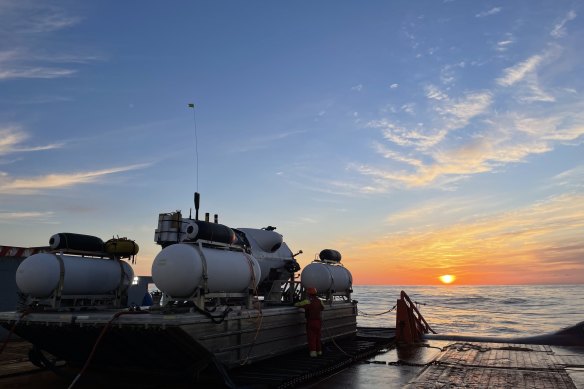
The Coast Guard led the initial search and rescue mission, a massive international effort that likely cost millions of dollars.

OceanGate Titan ready for a Titanic expedition in 2022.Credit:
It was not entirely clear who would have the authority to lead what is sure to be a complex investigation involving several countries. OceanGate Expeditions, the company that owned and operated the Titan, is based in the US, but the submersible was registered in the Bahamas. OceanGate is based in Everett, Washington, but closed when the Titan was found. Meanwhile, the Titan’s mother ship, the Polar Prince, was from Canada, and those killed were from England, Pakistan, France and the US.
The National Transportation Safety Board said on Friday that the US Coast Guard has declared the loss of the Titan submersible to be a “major marine casualty” and the Coast Guard will lead the investigation.
The Coast Guard has not confirmed that it will take the lead.
The deep-sea investigations promise to be long and painstaking, given the murky depths of the ocean.
Loading
“This is an incredibly unforgiving environment down there on the seafloor,” said Rear Admiral John Mauger, of the Coast Guard First District.
How the overall investigation will proceed is complicated by the fact that the world of deep-sea exploration is not well regulated.
A key part of any investigation is likely to be the Titan itself. Questions have been raised about whether the vessel was destined for disaster because of its unconventional design and its creator’s refusal to submit to independent checks that are standard in the industry
The Titan was not registered as a US vessel or with international agencies that regulate safety. And it wasn’t classified by a maritime industry group that sets standards on matters such as hull construction.
OceanGate chief executive Stockton Rush, who was piloting the Titan when it imploded, complained that regulations can stifle progress.
“Bringing an outside entity up to speed on every innovation before it is put into real-world testing is anathema to rapid innovation,” Rush wrote in a blog post on his company’s website.
One question that seems at least partially resolved is when the implosion likely happened. After the Titan was reported missing, the Navy went back and analysed its acoustic data and found an “anomaly” on Sunday that was consistent with an implosion or explosion in the general vicinity of where the vessel was operating when communications were lost, said a senior US Navy official.
The Navy passed on the information to the Coast Guard, which continued its search because the data was not considered definitive, according to the official, who spoke on condition of anonymity to discuss a sensitive acoustic detection system.
Loading
The Titan launched at 8am that day and was reported overdue that afternoon about 700 kilometres south of St John’s, Newfoundland. Rescuers rushed ships, planes and other equipment to the area.
Any sliver of hope that remained for finding the crew alive was wiped away early on Thursday, when the Coast Guard announced that debris had been found near the Titanic.
Killed in the implosion were Rush, two members of a prominent Pakistani family, Shahzada Dawood and his son Suleman Dawood; British adventurer Hamish Harding; and Titanic expert Paul-Henri Nargeolet.
A flurry of lawsuits is expected, but filing them will be complex, and it’s unclear how successful they will be. Plaintiffs will run into the problem of establishing jurisdiction.
At least 46 people successfully travelled on OceanGate’s submersible to the Titanic wreck site in 2021 and 2022, according to letters the company filed with a US District Court in Norfolk, Virginia, that oversees matters involving the Titanic shipwreck.
But questions about the submersible’s safety were raised by both a former company employee and former passengers.
AP
Get a note directly from our foreign correspondents on what’s making headlines around the world. Sign up for the weekly What in the World newsletter here.



























